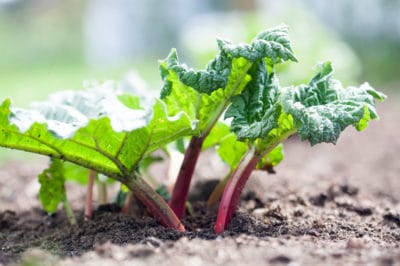Why the Timing Matters
Rhubarb plants need time in the ground to develop root systems and to get enough nutrition to begin producing edible stalks. Transplanting at the wrong time of year results in an unproductive plant that may not survive the winter to become active the next year.
Healthy rhubarb plants need to have their root crowns separated and transplanted every two or three years to keep the plant productive. This is best done in the fall or spring, before or after the growing season. These sections need to be transplanted when the weather is cool so they can establish themselves.
If you are starting your rhubarb from seed, it’s important to get your seedlings into the ground at the right time so they’ll be well on their way to contributing to your garden’s bounty. Once starts are at least four inches tall, you can transplant them.
To ensure that your plants make it to the growing season, you want to get them in the ground at the right, cool-weather time of year.
Tips It’s Time To Transplant
It’s easy to know when to transplant your rhubarb. Look for these signs that it’s time to get your plants growing.
In early spring:
- The temperature is above freezing, but not yet warm.
- The ground is thawing, or beginning to
- Your rhubarb plants are not showing new growth
In late summer and early fall:
- Temperatures drop to “cool” level
- The ground hasn’t frozen but it’s not warm
- Plants are showing signs of dormancy
The Right Time to Transplant
While you can transplant rhubarb crown segments in early fall or early spring, the best time is in the spring just after the ground has started to thaw, but before your rhubarb plants are showing signs of new growth. This will allow the new start to establish roots and consume plenty of nourishment before the growing season starts.
If you are planting in spring, once you have prepared your planting holes be sure to add compost over the top of the soil and mix it in a bit. A heavy feeding plant like rhubarb will want a good meal while it gets started in your garden.
When you choose to transplant in early fall, be sure to mulch over the planting with a few inches of hay. This will insulate the plant from the coming winter, which is crucial to having rhubarb in the spring and summer.
